Five Creative Combo Spreads
Here's how to increase the drawing power of your decoys by mixing in multiple species
Here's how to increase the drawing power of your decoys by mixing in multiple species
By Wade Bourne
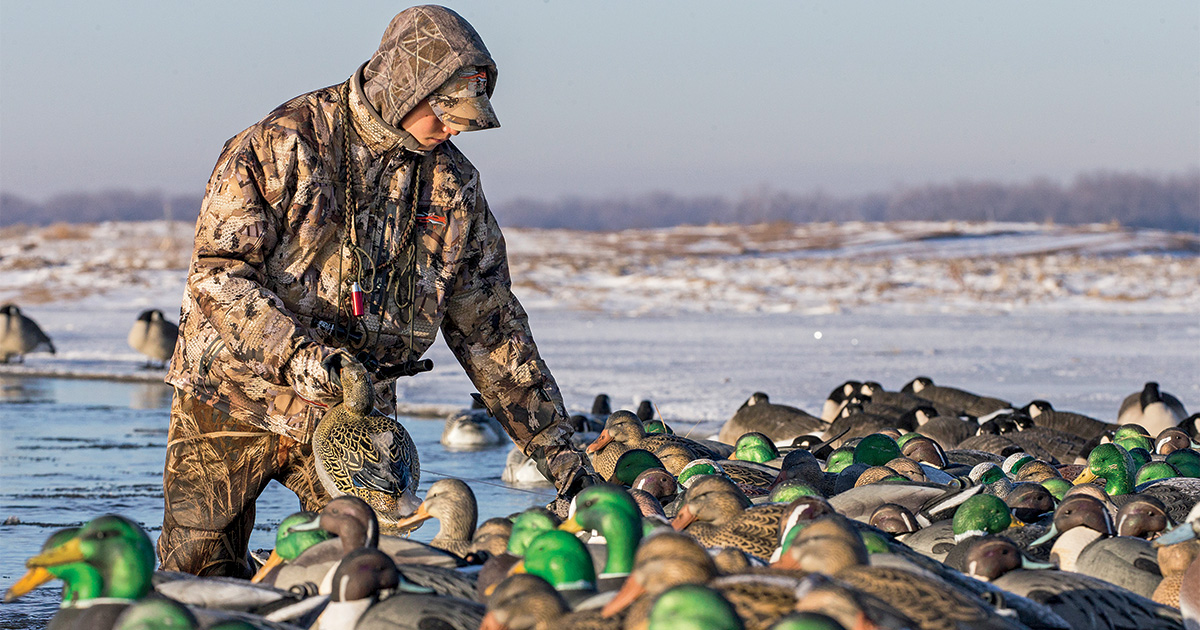
Good things often come in combinations-like mallards and specklebellies, Canada geese and snows, and black ducks and divers. The fact is, many waterfowlers strive to harvest a mixed bag. One of the best ways to do this is to customize your decoy spread to enhance its appeal to a variety of species.
But how should you set up to hunt ducks and geese over the same spread? What about puddle ducks and divers? The experts have the answers. Following are five combination spreads devised by veteran waterfowlers to help you diversify your harvest and bag more birds this fall.
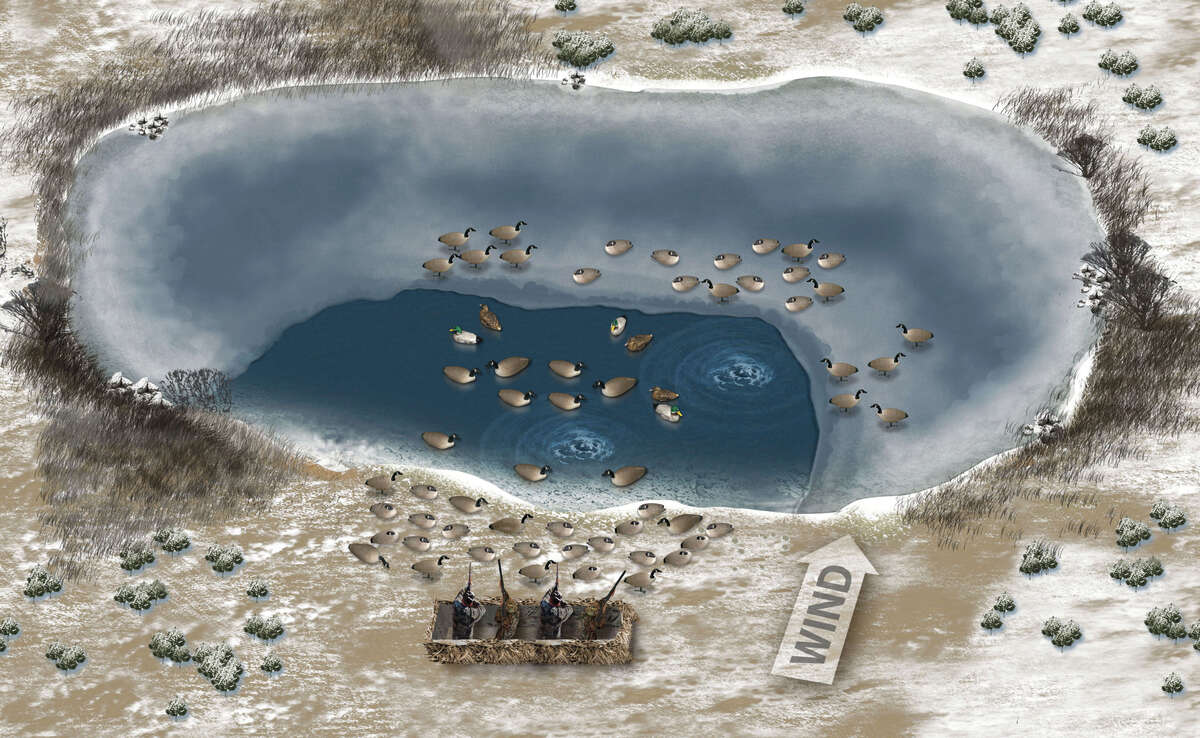
When hunting ducks and geese from a shore blind, deploying a mix of land and water decoys can help bring the birds in tight. That's the goal of Travis Reininger of Brighton, Colorado. Reininger operates Stillwater Outfitters, which specializes in hunting Canada geese in the shadow of this state's Front Range.
"Most of the geese in our area roost on big reservoirs. In the morning they fly out to feed in harvested corn and winter wheat fields. Then after feeding, they break up into smaller groups and loaf and rest on small ponds. We focus on these ponds, which can also provide great mallard shooting at times. We scout to find where the geese are resting, and we hunt from pits or above-ground blinds set back just a few yards from the water's edge. We always set up on the upwind side of a pond, or as close to upwind as we can be," Reininger says.
Because these ponds often freeze later in the season, Reininger uses portable Ice Eater de-icers to provide open water for the geese. "We keep Ice Eaters going in several ponds. We typically set a unit in the water about 10 yards off to one side of the blind and the other unit in front of it. This will provide an area of open water that's about 70 to 80 yards wide. Then we check the ponds in the afternoon to see where the prospects are best for the next day's hunt."
While hunting these partially frozen ponds, Reininger uses a mixed spread of Canada goose decoys, consisting of five dozen sleeper shells, two dozen full-bodies, and two dozen floaters. He lines the shoreline between the blind and the water with sleeper shells, packing them close together to look like resting birds. He places a dozen more sleepers on the ice on the far side of the hole, and mixes in full-body decoys with the sleepers throughout the spread. "The full-bodies look like geese that are up and walking around, maybe to get a drink of water," he says.
Reininger sets his Canada goose floaters in two groups, one along the shoreline and the other about 25 yards directly downwind from the blind. He scatters a half dozen mallard floaters among the geese for added realism. "Overall, I want my decoys to simulate what real ducks and geese do on small ponds-loafing and relaxing," Reininger says.
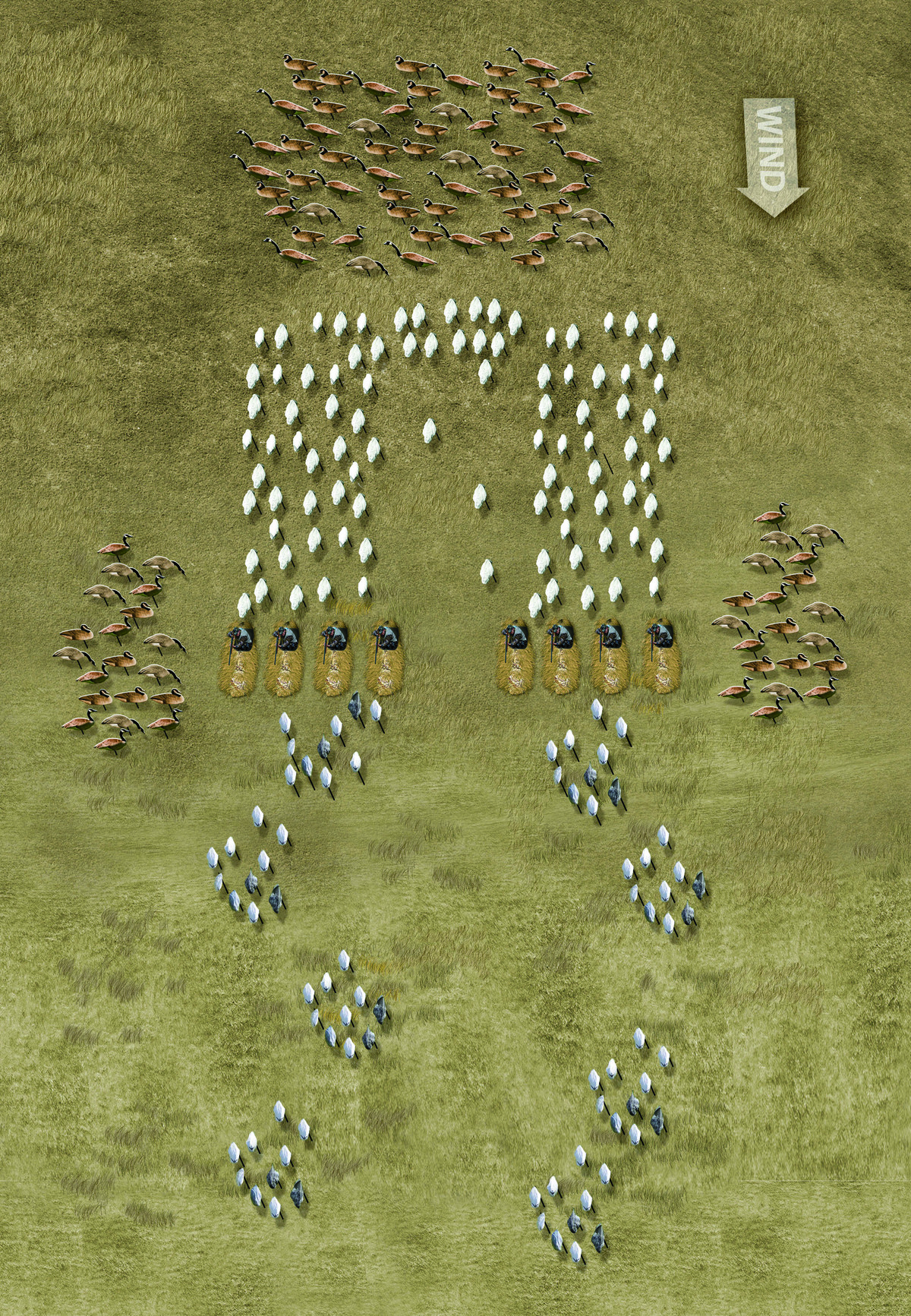
For more than 20 years, Stan Anderson of Lexington, Tennessee, has traveled with several friends to hunt geese in central Saskatchewan. In that region, it's not unusual to encounter Canada and snow geese feeding in the same fields. So Anderson and his hunting partners developed a mixed decoy spread that works equally well for both species. "On many mornings you can shoot both light and dark geese from the same spot," he says.
Anderson's spread consists mainly of snow goose decoys, with three groups of Canada goose decoys set at strategic locations around the snows. "Canadas and snows usually don't mix, so we always keep these species separate. First we set two large rectangular groups of white wind socks. Each group contains about 350 decoys and measures approximately 25 yards across and 50 yards long. We set the groups side by side, leaving an open lane about 25 yards wide between them. We call this lane lsquo;the runway.' Snow geese approach from downwind and follow the runway up through the middle of the spread," he says.
For concealment, Anderson and his partners hunt from layout blinds placed on either side of the runway on the downwind edge of the main body of snow goose decoys. "We set two dozen snow goose shells on stakes around our layout blinds to help hide them. Then we run a string of family groups, each consisting of 10 wind socks, downwind from the big mass of decoys. We set these family groups on either side of the runway, up to 70 yards downwind from our layout blinds. Then we add additional snow goose decoys to make the spread look more realistic. We scatter a few wind socks in the runway, especially on the upwind edge of the spread," he notes.
Last, Anderson and his hunting partners set three separate groups of Canada goose decoys on the periphery of the snow goose spread. "We put one group of 48 Canada goose silhouette decoys at the back of the snow goose spread, leaving 20 yards of open ground between them and the snows. Then we place three dozen Canada goose shells on each side of the big mass of snow goose decoys. These groups of decoys are roughly even with our layout blinds and about 20 yards outside the snows," he explains.
According to Anderson, decoying snow geese typically glide up the runway, offering good shots for hunters in the layout blinds. The hunters rely on their calling skills to steer incoming Canadas toward the center of the spread. "The birds might be headed toward the Canada goose decoys on their first approach, but we can usually pull them over the runway with our calls," Anderson says.
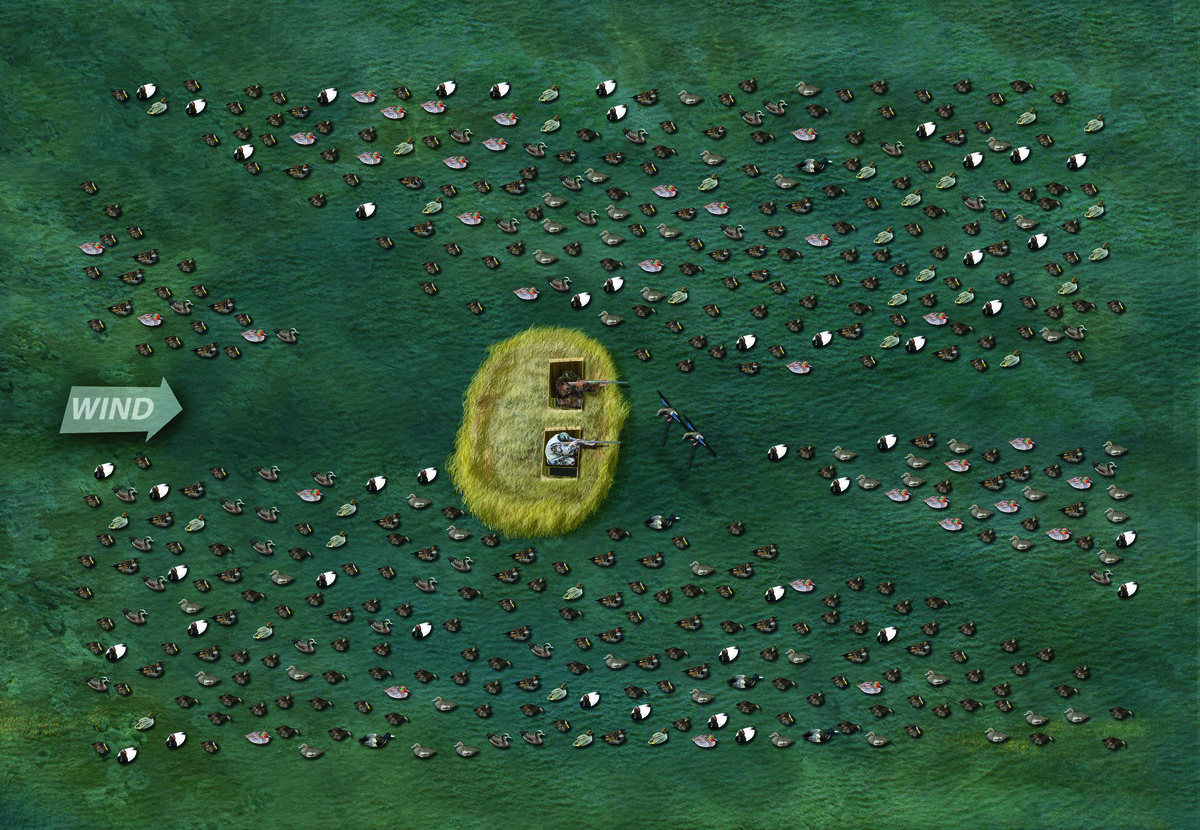
Captain R.J. Waldron, who operates North Wind Outfitters in Concord, California, guides waterfowlers for puddle ducks and divers in the Sacramento Valley. "We hunt from a pit in a shallow flooded field. Our main puddle ducks are pintails, wigeon, and green-winged teal, and our most common divers are canvasbacks, greater and lesser scaup, ring-necked ducks, and buffleheads. We put out a large spread of puddle duck and diving duck decoys mixed together and leave them out all season," he says.
Large spread, indeed! Waldron deploys some 1,200 decoys. "We hunt over approximately 1,000 acres of open water, so we need a big profile to attract ducks from long distances. Not many hunters are going to put out that many decoys, but you can scale down the number in this configuration and still effectively work both puddle ducks and divers. About 90 percent of our spread consists of puddle duck decoys of various species, and the remaining 10 percent are diving duck decoys. The white paint on the canvasback drakes really stands out and catches the attention of passing ducks," he attests.
Waldron places his decoys in a rectangular shape around the pit, which faces east and west. His spread extends 50 yards to the north and south of the pit and 75 yards to the east and west. He packs large numbers of decoys together near the pit and spaces them farther apart toward the outer edges of the spread. He leaves a small pocket of open water around the pit to serve as a landing zone and creates four open "flight lanes" throughout the spread.
"Incoming ducks follow these lanes like highways," Waldron says. "Our prevailing wind is from the northwest, so we leave two lanes on the east (downwind) side of the pit. One lane runs from the pit to the southeast, while the other runs straight east. These lanes, which are 10 yards wide, extend from the open pocket around the pit all the way to the outer edge of the spread."
Waldron also creates two flight lanes on the west side of the pit to help decoy birds when the prevailing wind is east to south. One lane runs straight west, while the other extends to the northwest corner of the spread. "Depending on the wind direction, we put two spinning-wing decoys at the intersection of the lanes that the birds are most likely to use that day. When ducks are coming in, they fly up the open lanes right to the spinners, providing us with close shooting," he says.
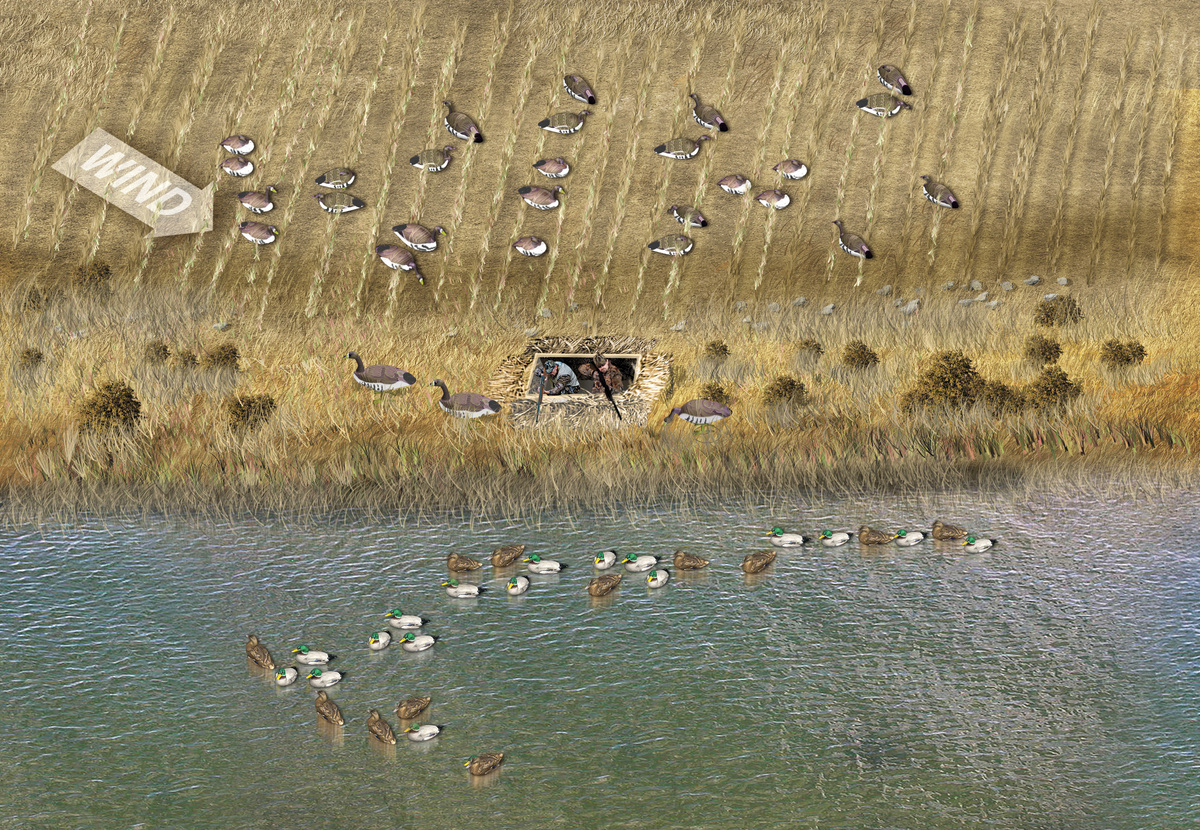
Brook Richard grew up in Lafayette, Louisiana, where he took to this region's waterfowling lifestyle early on. When he turned 20, he began guiding waterfowl hunters in Arkansas. Today Richard is program manager for Higdon Outdoors. He specializes in hunting ducks and white-fronted geese (aka specklebellies) in harvested rice fields.
"You can hunt ducks and specks out of the same pit, at the same time, with equal opportunity to take both," Richard says. "However, specks don't like to mix with ducks, so I set my duck decoys on the water in front of the pit and my goose decoys in the dry rice stubble behind it."
Richard uses three to four dozen oversized mallard decoys, which he places in a J formation running downwind or crosswind from the pit. "I place the main body of decoys off the upwind end of the blind and run a long line of decoys that stretches downwind," he says. "With this setup, ducks will circle downwind and then work back toward the landing zone in the bend of the J, right in front of the pit.
"When it comes to specklebellies, I go with full-body decoys on stands or stakes," Richard continues. "I set out from six decoys to two dozen, depending on the sky conditions. I use fewer decoys on cloudy days and more when it's sunny.
"I arrange my specklebelly decoys in groups of two or three each, and leave plenty of room between these groups. I set individual decoys two to three feet apart, and leave 10 to 15 feet between the groups. This spread provides plenty of room for geese to land. Specks like to land among feeding birds."
For added realism, Richard sets a few goose decoys on the levee on each side of the pit. "This looks like some geese have landed in the water and are walking over the levee to join the other specks on dry land. These decoys also help hide the hard edges of the pit," he says.
Richard offers two more tips: "In my goose spread, I like to use more feeder decoys than those with upright heads. This helps create the appearance of contentment. Also, I don't set any decoys farther from the pit than I'm willing to shoot. I keep all my decoys-both ducks and geese-inside 45 yards,"he says.
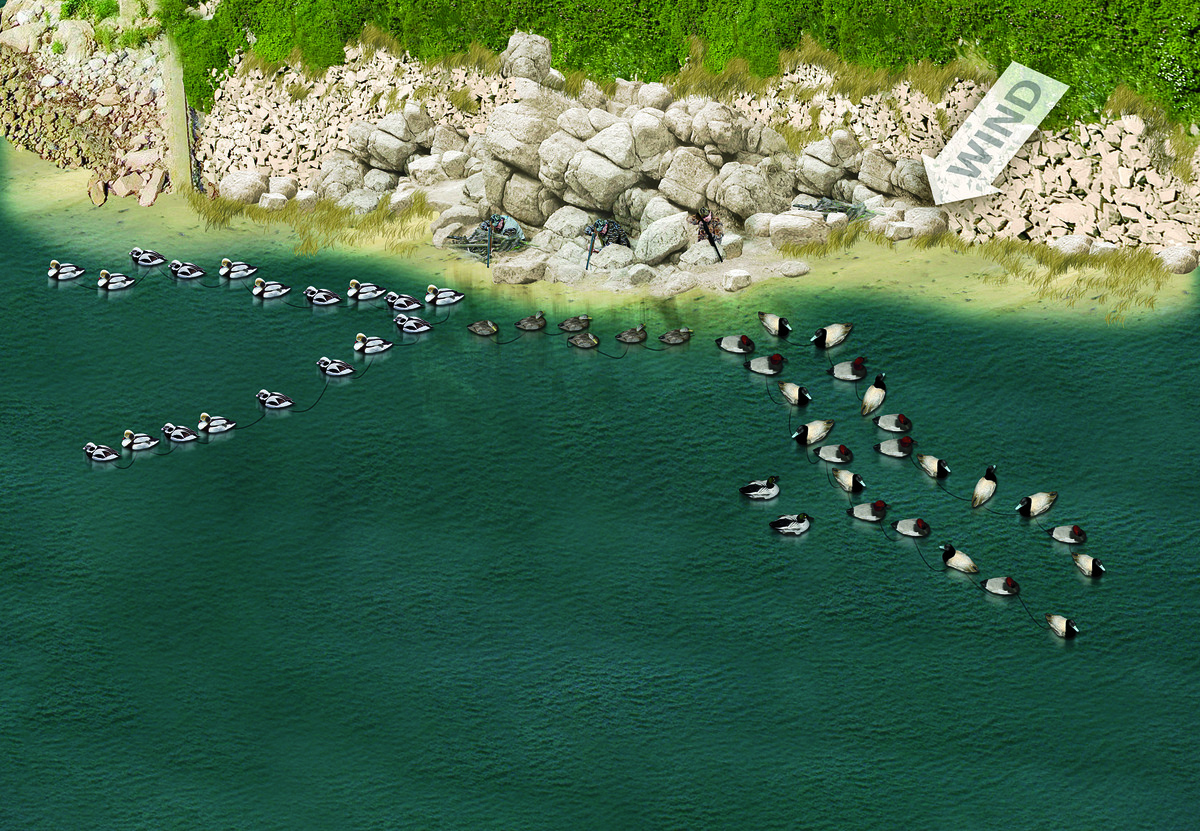
Along the Atlantic coast, many waterfowlers have the opportunity to harvest a mixed bag of sea ducks, divers, and dabblers. Dave Miles, who is the marketing director for O.F. Mossberg and Sons in Seymour, Connecticut, hunts all three types of waterfowl along the shores of Long Island Sound employing techniques that he learned from his duck-hunting mentor and close friend Terry Thomas. Miles and his hunting partners set a mixed-species decoy spread close to islands, rock outcroppings, breakwaters, and points where a variety of ducks trade and rest.
"We always set up on the leeward side of whatever structure we're hunting from. Black ducks, especially, like to sit close to shore in smooth water. We set a line of six black duck decoys along the shoreline in front of our shooting position. Mallards and other dabblers will work into black duck decoys, but black ducks seem to be a bit more picky," Miles says.
Next the hunters set two longlines, each rigged with long-tailed duck decoys, off to one side of the black duck decoys. One line runs along the shoreline while the other angles downwind to form a V. "The goal is to get incoming sea ducks to fly between the two decoy lines. When everything works right, the birds try to land in the middle of the V or just off to the side in close shotgun range," Miles explains.
To attract diving ducks, the hunters set two more longlines, each strung with scaup and canvasback decoys, on the other side of the black duck decoys. "We run these lines fairly close to each other so the decoys look like a solid raft of divers. We usually leave a little slack in the lines so they sag downwind slightly in the middle. The last thing we do is place a pair of goldeneye decoys on the leeward side of the divers. Goldeneyes won't land with other diving duck decoys, but they drop in right beside our goldeneye decoys," Miles says.
One more important note: Miles and his hunting partners move their spread in response to the ebb and flow of the tide and to changes in wind direction. "It's important to keep the decoys in the right position. Sometimes moving them just a few yards will make a big difference in how the ducks respond and the types of shots we get," he says.